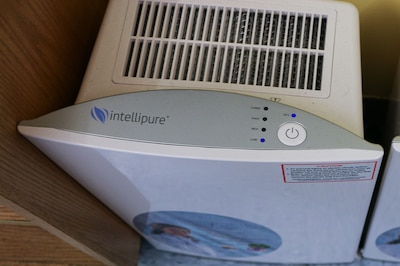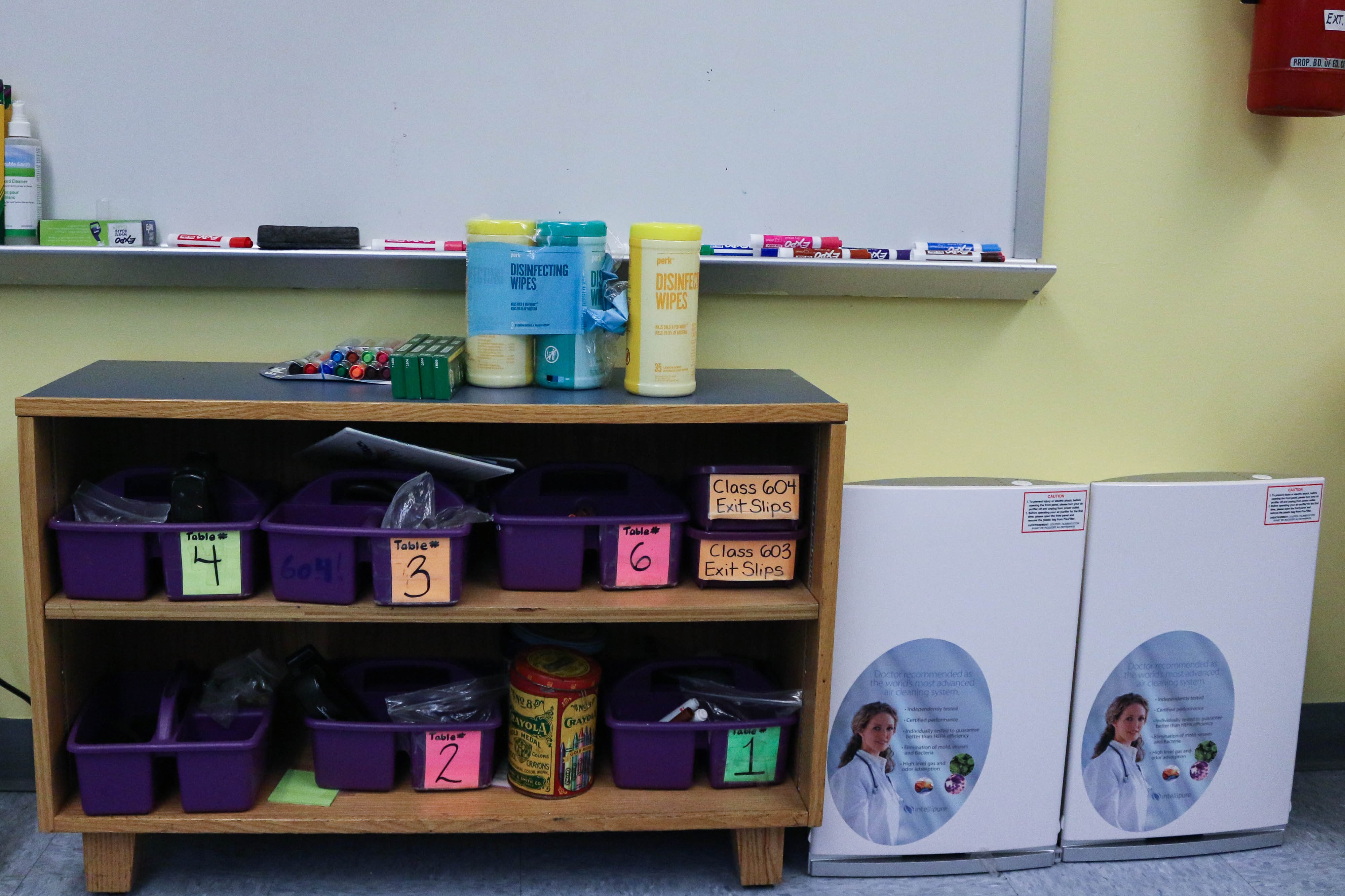This story was updated to include additional information from the company that distributes the purifiers about other lab results and measures of determining how well a device works.
Sarah Allen gave a small sigh of relief when an air purifier arrived last winter in her first grade classroom.
The Brooklyn teacher knew that experts recommended purifiers with high-efficiency particulate air, or HEPA, filters as a way to add another layer of protection against the transmission of the coronavirus, along with masks and social distancing. But when she looked into the Intellipure Compact device, Allen learned it didn’t have a HEPA filter. Instead, according to the company’s website, it was “certified to guarantee better than HEPA efficiency.”
Unable to find anything on Google about the company’s promised technology, Allen called them three times. The company promised to send more information, but never got back to her.
When school starts this year, Allen expects her classroom to have a second purifier, part of a plan by the education department to put two such devices in every classroom. Department officials said over the summer they would buy about 100,000 of the air purifiers, just one aspect of the department’s multi-pronged approach to fighting COVID.
Allen didn’t feel relieved by the widely praised news. She wanted to know more about the device created by central New York-based HealthWay and distributed by Delos, a New York City-based company that created a wellness living seal-of-approval for buildings to demonstrate their indoor environments use healthy materials.
The city has spent at least $43 million to buy the devices, including replacement filters, according to publicly available contracts. Other school districts, including Chicago, Miami-Dade and Baltimore, purchased the same model as New York City. Delos retails the Intellipure model starting at $549, and replacement filters cost $220. (School districts likely got a discount.)
Brent Stephens, a professor and chair of the civil, architectural, and environmental engineering department at the Illinois Institute of Technology, recently conducted an independent test of the product after Allen raised concerns about the device on social media. The Intellipure was among the least efficient, he found. It ranked ninth out of the dozen his team tested in terms of its clean air delivery rate, or CADR, which measures how often a purifier turns over the air in the room.
“It’s not nothing, but it’s certainly not the highest on the market,” Stephens said.
Intellipure’s CADR for the smallest particles tested was about 129 cubic feet per minute, according to Stephens’ findings. But lab data from certified testing facilities found the Intellipure device had a CADR of about 145 cubic feet per minute, according to Delos.
“There are good HEPA filtration systems on the market that cost in the range of $250 that have double that CADR value and so will be much more effective at removing aerosol particles from classroom air,” said Richard Corsi, the incoming dean of engineering at the University of California, Davis, and an expert on indoor air quality.
Air exchange rates
Allen was also concerned upon seeing that her classroom purifier was recommended for a room of about 500 square feet. Allen’s was 625 square feet.
In the face of a virus spread by aerosol transmission, a room’s air should turn over four to six times an hour, according to Harvard’s Healthy Buildings initiative.
With Allen’s 14-foot classroom ceiling, two Intellipure purifiers would yield about 1.8 air exchanges per hour, according to Stephens’ findings. That’s slightly less than recommended by the company.
Representatives from Delos said they advised the education department to have at least two air changes per hour, something that could be achieved with two purifiers in every room, depending on the size and volume of a given room.
The average New York City classroom is about 650 square feet, according to an analysis from the Independent Budget Office. If such a room has 10-foot ceilings, two purifiers would indeed change the air about twice an hour based on estimates from Delos as well as the numbers from Stephens’ lab.

Education department officials noted that air purifiers are just one part of several layers of mitigation against COVID, including mandatory masking, social distancing, when possible, and random coronavirus testing. Teachers will be required to be vaccinated or submit to weekly testing, and the city has ramped up efforts to get eligible students vaccinated, though children under 12 may not be eligible for months.
The city has also upgraded HVAC systems to ensure air is moving through classrooms.
“Our multi-layered approach to safety made schools some of the safest places to be during this pandemic,” said education department spokesman Nathaniel Styer. “We look forward to welcoming all our students and staff back in September, with fully operational ventilation systems and two HEPA purifiers in each classroom.”
The education department calls the Intellipure device HEPA purifiers since they claim to remove 99.99% of airborne particles down to .007 microns in size. Delos representatives acknowledged that the device does not use a HEPA filter, but they said the purifier meets and exceeds HEPA benchmarks for filtration.
Unlike HEPA filters, the Intellipure device uses a high-voltage system to deliver positive ions within the filtration unit to kill the smallest particles, Delos officials said. The devices use ions to charge the particles to make them easier to catch in the filter and also uses grounding devices in a pre-filter as well as on the filter’s other end to prevent ions from escaping, the company said.
Delos representatives also said that while HEPA filters are recommended to be changed every three to six months, their model’s filters last longer and additionally can capture fumes, solvents, cleansers, and other volatile organic compounds.
They added that the filter efficiency and CADR aren’t the only important things to measure. Other key metrics include the machine’s size, weight, energy consumption, filter maintenance and noise level.
The company also emphasized the importance of their device’s single pass efficiency ensuring that captured aerosols aren’t inadvertently spread in a room. Delos said a purifier may have a high CADR if it has a high speed fan, but the particles might not be efficiently captured and could then be recirculated in the room.
Not bad or good
Several indoor air quality experts remain unconvinced that this device is more efficient than less pricey HEPA ones on the market. They said purifiers with HEPA filters are not only more cost effective, but are the only proven technology. The Centers for Disease Control and Prevention also recommends purifiers with HEPA filters.
“It’s not bad, and it’s not good,” said Jim Rosenthal, past president of the National Air Filtration Association and CEO of Texas-based Tex-Air Filters, of the test results of the Intellipure device from Stephens’ lab. Even a simple DIY purifier made from a box fan and MERV 13 filter could turn over more air, said Rosenthal.
“No question it’s better than nothing,” Rosenthal said of the device New York City purchased. “I certainly feel better with two of these operating than nothing at all. Most schools just don’t have good ventilation systems. It’s a chronic problem.”
Last school year, before the education department’s purchases, hundreds of teachers turned to crowdfunding platforms to raise money for classroom purifiers.
Jeffrey Siegel, the chair in civil engineering in the department of civil and mineral engineering at the University of Toronto, said the CADR of the Intellipure/Healthway device is “not terribly unreasonable for a small-medium sized bedroom.”
But, he added, “For a large classroom, definitely underpowered.”
He was glad to see the results from Stephens’ lab showed no harmful byproducts were emitted — some purifiers with ionizers can be harmful. (Ions are associated with negative cardiovascular outcomes. Certain ionizing devices can also emit ozone, which is a respiratory hazard and could exacerbate issues like asthma.)
But Siegel said it was also important to understand how the devices perform over time.
“As the filter loads in most units, the flow diminishes, and so the CADR will likely go down,” he said. “In some cases, this can be significant.”
For classrooms that have good ventilation, Siegel explained, purifiers may not help that much. But for the rooms that don’t have good ventilation, purifiers can be crucial.
“Some will benefit a lot, some will benefit a little,” he said.
Layers of protection
Allen, the Brooklyn teacher, remains disappointed with the education department’s choice, but hopes it’s a learning opportunity for the department to lean more on other experts and to ensure that other layers of protection, such as masking, are enforced. (Masks will be mandated this year.) She wondered, for instance, if the city could get child-size KN95s, as Utah is distributing to kids. (Though unlike New York, Utah is making masks optional in schools.)
“My hope is that we don’t fall back on ‘Oh well, we blew a lot of money on these purifiers’ or ‘They’re not the WORST purifiers,’” she said. “We should be pursuing effective and thorough mitigations for our children.”
Stephens, the researcher, said he hoped the city was giving educators some ideas for how to use the air purifiers. They shouldn’t be placed near a window or they will end up cleaning fresh air, he advised. Putting the devices at opposite ends of the room might be most effective.
“The truth is, wherever you have power and kids won’t mess with it is the best place,” said Stephens. “I went to public school. You just do the best you can. You don’t want the perfect to be the enemy of the good.”
Annie Fu and Pooja Salhotra contributed.







